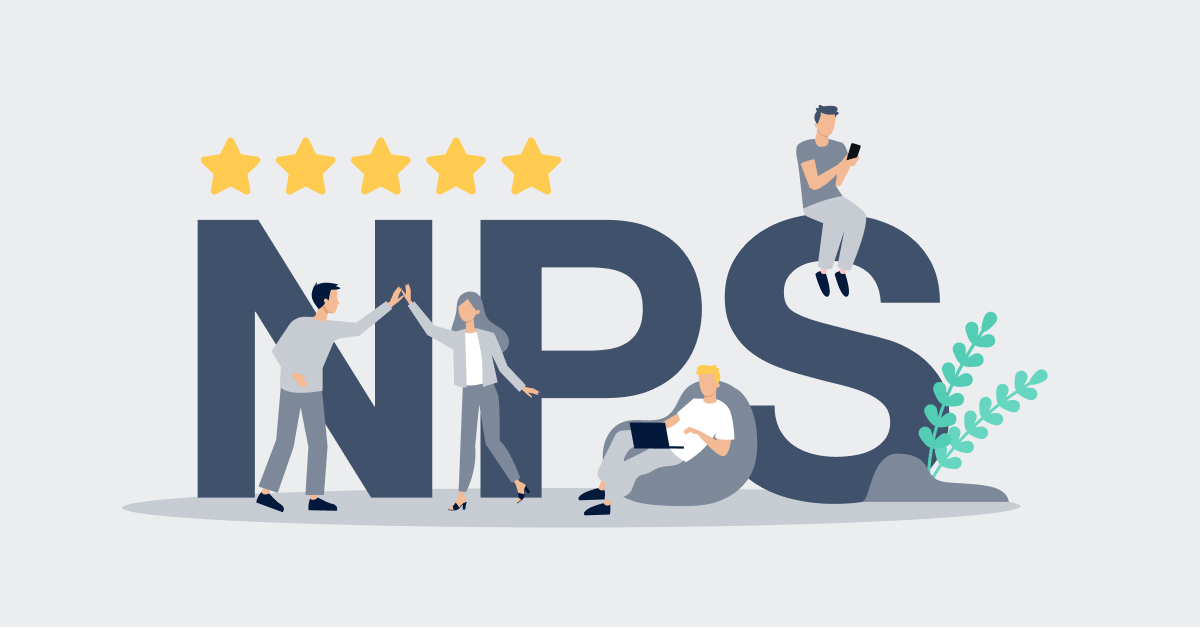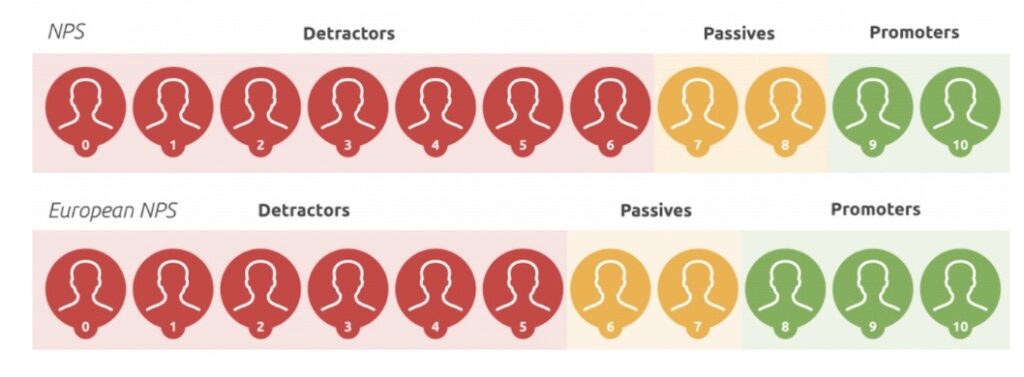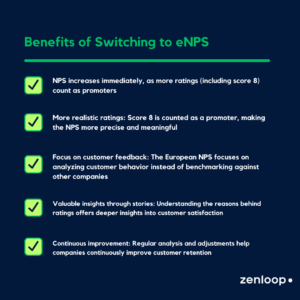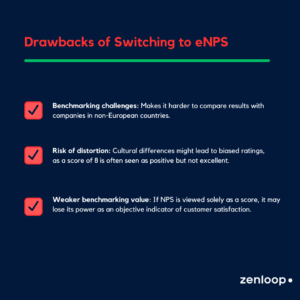NPS in Transition – Why More and More Brands Should Use the European NPS
The Net Promoter Score (NPS) is a globally recognized metric that measures how likely customers are to recommend a company to others, serving as a key indicator of customer satisfaction and loyalty. Today, almost every organization relies on NPS to better understand and improve customer experiences. However, interpreting NPS results isn’t universal—what may be considered a high score in one region could be average in another. European businesses, in particular, often record significantly lower NPS scores than their US counterparts, not necessarily due to lower satisfaction, but because of cultural differences in scoring behaviors. This discrepancy raises important questions: Why do these differences exist? How does the European NPS model address these unique regional challenges? What are the true advantages and disadvantages of adopting the European NPS framework? In this article, zenloop explores these critical topics, highlighting why the European NPS is emerging as a best practice across the continent. As more brands recognize the benefits of this localized approach for accurate benchmarking and actionable insights, zenloop proudly leads the way by integrating the European NPS into its own platform, offering companies the choice and flexibility to best fit their customers’ needs.

How does the classic NPS differ from the European NPS?

The classic NPS divides feedback into three categories: Detractors (ratings from 0 to 6), Passives (scores of 7 and 8), and Promoters, which only include the highest ratings of 9 and 10.
Want to learn more about the classic NPS?
In these other blog articles, you’ll find exciting insights and perspectives on the Net Promoter Score.
If you’d like to read more about what exactly NPS is, just click here.
The European NPS differs from the classic NPS in some aspects. As with the classic model, feedback is divided into the three categories of Detractors, Passives, and Promoters. However, the European NPS defines the boundaries slightly differently: Detractors range from 0 to 5, Passives from 6 to 7, and Promoters start at a rating of 8 and go up to 10.
Why do European companies perform worse in the NPS?
European companies perform significantly worse in the NPS due to cultural differences in the rating systems.
A good example is the response behavior of Americans. On a scale of 0 to 10, they tend to choose more extreme values – in particular, they more often give a solid 10.
In Europe, however, the number 8 is the most frequently awarded rating.
Despite impeccable service, Europeans usually only give a 10 for exceptional experiences – it remains the exception, not the rule.
Are you interested in how the NPS is used specifically in Germany? Then be sure to check out this blog post!
Why does switching to the European NPS make sense?
Switching to the European NPS makes sense because the 8 is awarded particularly frequently in Europe, which automatically lowers the classic NPS than in other regions. This is because an 8 still counts as a passive, not a promoter.
Many Europeans consider an 8 to be very good feedback. This is precisely why it should also be assigned to the promoters – in the interest of a more realistic picture.
What advantages does switching to the European NPS bring in this context:
- NPS increases directly, as more reviews (with a score of 8) count as promoters.
- More realistic reviews: An 8 is counted as a promoter, making the NPS more accurate and meaningful.
- Focus on customer feedback: The European NPS encourages the analysis of customer behavior rather than competition with other companies.
- Valuable insights through stories: The reasons behind the reviews provide deeper insights into customer satisfaction.
- Continuous improvement: Through regular analysis and adjustment, companies can continuously improve the customer experience.
What are the disadvantages?
- Complicates benchmarking comparisons with companies in non-European countries
- Risk of bias: Cultural differences could distort ratings, as an 8 is often viewed as positive but not as an excellent rating.
- Difficult benchmarks: If the NPS is viewed purely as a score, it could lose its function as an objective indicator of customer satisfaction.


Why is a European NPS still not a simple solution?
Even if the idea of a European Net Promoter Score sounds logical at first, the eNPs is not a simple solution, as cultures rate differently, so the NPS should also be adapted. However, in practice, it turns out that differences exist not only between Europe and the US – even within Europe, rating behavior varies considerably. A uniform “EU NPS” solution is therefore insufficient.
Furthermore, it has been shown that European customers who assign a 9 or 10 are often particularly loyal and committed promoters – precisely because they rarely assign higher ratings. An 8 may be considered “good” in Europe, but it is rarely a true sign of active recommendation. In the US, however, high ratings are culturally easy to assign, but this does not always translate into genuine loyalty or a genuine recommendation.
Conclusion
NPS is an important tool for measuring customer satisfaction, but in Europe, the classic NPS often doesn’t reflect reality. Cultural differences lead to lower NPS scores compared to other regions, such as the US. The European NPS offers a more accurate representation by counting ratings of 8 as promoters. This not only leads to a higher NPS, but also to valuable insights and continuous improvement of the customer experience. However, the European NPS can also present some challenges, as adapting to regional rating practices requires careful consideration to enable truly accurate analysis and recommendations for action.
zenloop has now integrated the European NPS into its platform. As a brand, you now have the choice of which NPS system you prefer—the classic model or the European NPS. At zenloop, we are convinced of the benefits of the European NPS and are pleased to offer this new alternative. It has been shown that the choice of NPS system has a significant impact on the NPS score. Therefore, we want to give companies the freedom to decide for themselves which system best suits their corporate culture and their customers. After all, you know your customers and their needs best.
We invite companies to try out the European NPS and discover how it can help them optimize customer satisfaction.
FAQ
Is the NPS scale 1–10 or 0–10?
The classic NPS scale ranges from 0 to 10, with 0 being the worst rating and 10 being the best. However, some adjustments to the scale exist depending on the regional context.
What is the NPS score for KLM?
KLM’s Net Promoter Score (NPS) increased from 37 to 39 in 2023, despite challenging conditions such as a limited fleet – a result of the strong commitment of all employees and a sign of increasing customer satisfaction.
What are the different types of NPS?
- Transactional NPS or tNPS
- Relationship NPS or rNPS
- Employee NPS or eNPS.
What is the difference between NPS and eNPS?
The difference between the two terms is that the Net Promoter Score (NPS) assesses how loyal and committed customers are to a company. The Employee Net Promoter Score (eNPS), on the other hand, focuses on the internal perspective: It shows how employees perceive their company as an employer and whether they would recommend it to others.





